Chess is a popular strategy board game that is played worldwide. There are over 600 million people that play the game. Since its inception, there have been multiple changes to the rules and structure of the game. However, chess has always remained a game that is played between two players. As the game evolved, however, new variants were created. One of these variants is known as “Three Player Chess.”
We all know that the standard game of chess is played between two persons and is said to be over when one of the players is checkmated. But what happens when the chess board is designed in such a way that it’s not restricted to two persons but also permits an extra person to play? We call that “Three player Chess.”
What Is Three Player Chess?
As noted earlier, Three player chess is a chess variant that three persons can play. It’s sometimes called three-handed chess, three-man chess, or three-way chess.
History of Three Player Chess
Three player chess has been around for several decades, and over time it has evolved and gained popularity in different parts of the world.
The variant was first invented in the 1960s by the mathematician and physicist David Levy. Levy was interested in exploring the possibilities of chess played by three people, and he developed a set of rules that would allow for this. His initial concept was refined over time and eventually became the game it is today.
The variant began to really gain the attention of the chess world when it garnered interest from the world’s chess superpower at that time, the Soviet Union.
Three player chess gained popularity in the Soviet Union in the 1970s and 1980s, where it was seen as a way to promote cooperation and communication between players. The Soviet Chess Federation even held a national championship in three player chess in 1984. Through the recognition from the world’s elite chess playing nation at that time, the popularity of Three Player Chess began to grow.
The Three Player Chess variant is an interesting one as it employs a non-standard board. Obviously, you can’t play Three-player chess on a standard 8×8 chess board. The chess boards employed for this kind of variant are usually hexagonal or circular.
Check out the images below:


How Is The Three Player Chess Board Set Up?
As we can see from the images, three players are able to compete against each other on a hexagonal-shaped/circular-shaped board. These boards have a total of 96 squares unlike that of the standard board with 64 squares, so it’s an extra 32 squares for the third player.
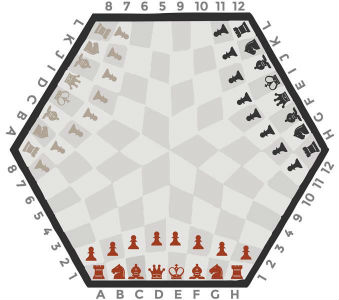
Each player starts with 16 pieces and this includes a king, queen, two rooks, two bishops, two knights, and eight pawns.
What’s The Idea Behind The Three Player Chess?
Just like the standard chess game, the aim of every player is to win by checkmating the other player’s king. In three player chess, however, the ultimate goal is to eliminate at least one king.
Recall the idea regarding the “check” move. A King is said to be in check if one of two of the opposing player’s pieces threatens it at that time. The same idea works in Three player chess.
Consider a game between Red, Blue and Black
(Color is frequently used to distinguish the three sides). Red’s King is said to be in check when either Blue or Black’s pieces threaten it. When Red’s King is no longer in a position to make a valid move and is still in check, checkmate happens.
The game will be won by the one who captures(checkmates) Red’s King. The small distinction between three player chess and traditional chess is what makes this game so much fun and interesting.
Does This Make Three Player Chess An Unfair Game?
Three player chess has spawned a slew of variants. They frequently employ a non-standard board, such as a hexagonal or three-sided board, with a unique way of connecting the central cells.
Three player chess variants (and other three-person games) are the most difficult to design equitably, because the imbalance created when two players team up against one is frequently too much for the defending player to handle. Some variants try to circumvent the problem by judging the winner as the person who delivers checkmate first, with the third player either losing in addition to the checkmated player or receiving a half-point.
How Do Pieces Move In Three Player Chess?
Do the chess pieces in Three player chess move the same way like those in standard chess? Yes, of course. The only difference has do with the slightly-confusing squares but the image below will help you better.

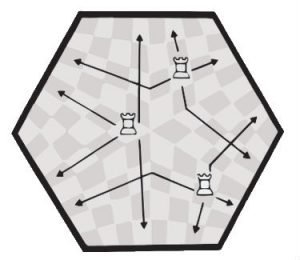
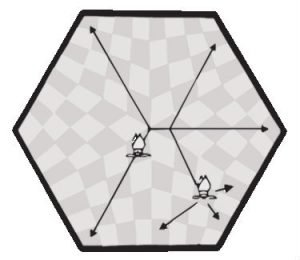
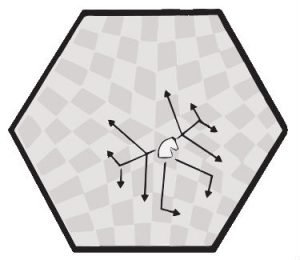

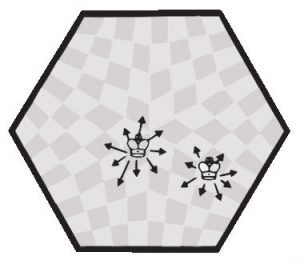
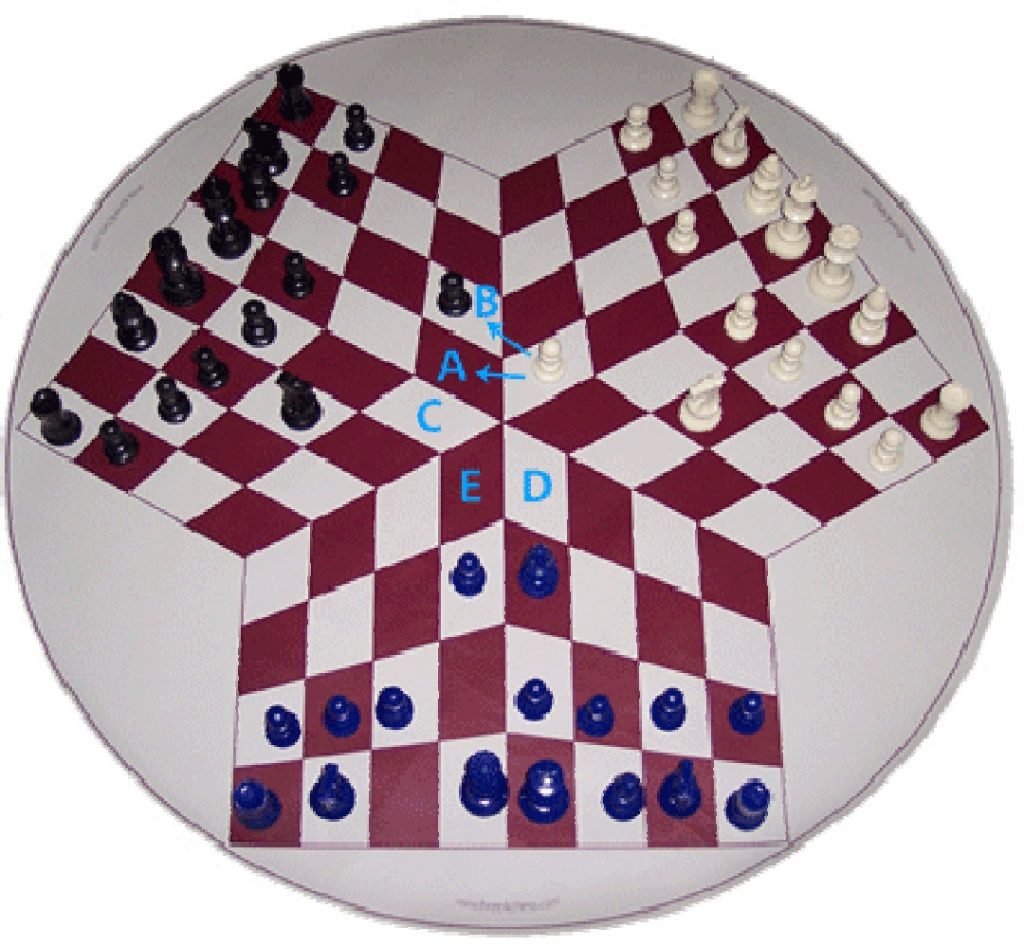
A demonstrative three-player chess board. Image: Exeter Chess
The middle squares in the Three player chess board can be confusing hence this important example.
In the position above, every player has made two moves each with white being the next to move. When white’s pawn moved forward, it lands on the red square labelled A. Just like the rules of pawns in chess, a pawn may only move diagonally if it captures an opponent’s piece. This simply means that the white pawn is able to capture the black pawn on the labelled B square. It also has the ability to take any piece on squares C and D. It may then proceed to the square labeled E. These are the only moves allowed, and they should demonstrate the difference between moving forward (squares A and E) and diagonally (squares B, C, and D).
Strategic Ideas And Plans In Three Player Chess
When it comes to Three player chess, the addition of a third player substantially changes the manner of play. Due to the enlarged board and third player, many chess openings applicable to the traditional board are simply not useful. Each player must plan twice as far ahead of time, anticipating both opponents’ actions.
The third player profits when the first player trades pieces with a second player. As a result, players will be less willing to make trades. Players frequently avoid such exchanges in order to pursue alternative strategies.
The introduction of the “extra” move by the third player can lead to deadlocks. Going back to our Red, Black, and Blue example, let’s imagine a scenario. Blue has a piece that is en prise and undefended and can be captured by both Red and Black pieces at the same time.
Of course, Black would hesitate to capture the undefended piece because that means that Red will surely capture Black’s piece after Black captures Blue’s piece. This can be a very funny and dramatic situation. Similarly, a piece can move to a square where it can be attacked by both opponents, but neither player will take it to avoid being captured by the next player.
Players must concentrate not only on their own attack and defense, but also on stopping the other two opponents from checkmating each other in games because the third player loses as well as the checkmated one (this depends on the agreed rules).
A player can use one opponent’s position to checkmate the other, but he or she must be careful not to checkmate the third player first. Blue may checkmate Red, but his piece would be captured by Black who would then checkmate Red. Blue would lose in this situation because Black made the final checkmate move.
How Does The Three Player Chess End?
There are two different ending scenarios that result from a game of three-player chess. The first is a last man standing scenario, in which the first checkmated player is eliminated and the game continues between two players.
The second is a truncated game, in which the first checkmated player loses along with one other, with the winner being the player whose pieces truly checkmate. There are times when both players’ pieces unite to checkmate someone; in these cases, the player who checked the checkmated party first wins.
Special Moves In Three Player Chess
Three Player Chess consists of special moves that are peculiar to the variant and cannot be found in standard chess.
These special moves include:
- When a queen or bishop moves along a long diagonal, it will change square colors if it crosses the center of the board.
- A king pawn or queen pawn on its fourth rank has three diagonally forward ways to capture. A pawn always captures in the direction of a square of the same color.
- A pawn that reaches its fifth rank gains the ability to move orthogonally in any direction and to capture diagonally in any direction. However, it may not reenter its own one-third portion of the board.
- A pawn has three possible promotion ranks: the back ranks of either opponent and the furthest rank directly opposite the player.
Variations Of Three Player Chess
There are a few popular variations of three player chess, each with its own unique rules and gameplay. Here are a few examples:
Fischer Random Three-Player Chess
This variation is based on Fischer Random Chess (also known as Chess960), a variant of chess in which the starting position of the pieces is randomized. In Fischer Random Three-Player Chess, the starting position is randomized for each player separately, meaning that each player has a different starting position. This makes the game even more unpredictable and forces players to adapt to new situations quickly.
Three-Player Bughouse Chess
Bughouse Chess is a popular variant of traditional chess in which players play in teams of two and can pass captured pieces to their partner to use on their own board. In Three-Player Bughouse Chess, three players compete against each other, and the rules of Bughouse Chess apply. This makes for a fast-paced and chaotic game that requires quick thinking and good communication between teammates.
Three-Player Chess 4-Way
In this variation, four players compete on a circular board with four different quadrants. Each player must defeat the player opposite them in order to win the game. This variation is notable for its unique board design and the fact that it allows for more players to participate in a game of three player chess.
Three-Player King of the Hill
In this variation, players compete to control the center of the board. The player who first places one of their pieces on the central hexagon wins the “hill” and can only win the game by checkmating one of their opponents while in control of the hill. This variation emphasizes control of the center of the board and can lead to some interesting strategic choices.
Three-Player Horde Chess
In this variant, two players team up against a third player who has a large number of pawns at the start of the game. The two players must work together to capture all of the pawns before the third player can checkmate one of them. This variant emphasizes teamwork and can be a fun way to mix up the usual dynamic of three player chess.
Benefits Of Playing Three Player Chess
Three Player Chess provides a variety of benefits to chess players. Some of these benefits will now be examined:
Improved Critical Thinking
Three Player Chess requires players to think several moves ahead, anticipate their opponent’s actions, and consider multiple objectives simultaneously. These skills can translate to real-life situations where critical thinking is essential, such as in decision-making processes, problem-solving, and strategic planning.
Enhances Problem-Solving Skills
In Three Player Chess, players have to think creatively to solve problems presented by the unique game board. They may have to find alternative routes to attack or defend their pieces, which can help them develop problem-solving skills that can be applied to other areas of life.
Increased Multitasking Ability
Three Player Chess players must focus on multiple objectives simultaneously, including both offensive and defensive strategies. This ability to multitask can be useful in real-life situations where people have to juggle multiple responsibilities and tasks.
Develops Patience
Three Player Chess is a game that requires players to be patient and wait for the right moment to make a move. This skill can translate to real-life situations where patience is essential, such as waiting for the right job opportunity or waiting for an investment to mature.
Boosts Memory
Three Player Chess requires players to remember the position of all the pieces on the board, which can help improve memory and recall skills.
Provides Social Benefits
Three Player Chess is a social game that can be played with friends or strangers. This social aspect can provide an opportunity for players to make new friends, improve communication skills, and learn from each other.
Famous Players Who Play Three Man Chess
Timur Gareyev
Timur Gareyev is a chess grandmaster who is known for his unconventional playing style and his love for Three Player Chess. He has set several world records for playing simultaneous games of Three Player Chess while blindfolded, including playing against 48 opponents in 2017.
David Sirlin
David Sirlin is a game designer and author who is known for his work on strategy games. He is also a Three Player Chess enthusiast and has written extensively about the game, including developing a strategy guide for players.
Andy Soltis
Andy Soltis is a chess grandmaster and author who has written several books on chess, including one on Three Man Chess called “Three-Handed Chess: A Three-Handed Game of Chess, You Have to Play to Believe!” He has also played in several Three Player Chess tournaments and is considered one of the top players in the game.
Tim Just
Tim Just is a software developer and chess enthusiast who created a popular online Three Player Chess game called “Trichess.” He has also organized several Three Player Chess tournaments and has written extensively about the game.
Frequently Asked Questions (FAQs)
What is the difference between Three Player Chess and Standard Chess?
Three Player Chess is similar to standard chess in many ways, but it is played on a unique board that consists of three 8×8 squares, with each player starting in the center square. The additional player creates unique challenges and strategic opportunities that are not present in standard chess.
Are the rules of Three Player Chess different from standard chess?
The rules of Three Player Chess are mostly the same as standard chess, with a few exceptions. For example, players can capture pieces from any opponent, not just the player they are facing. Additionally, a player can win by checkmating either of their opponents or by capturing both of their opponents’ kings.
How many players can play Three Player Chess?
As the name implies, Three Player Chess is designed to be played with three players. However, there are variations of the game that can be played with two or four players.
Is Three Player Chess a popular game?
While Three Player Chess is not as well-known as traditional chess, it has a small but dedicated following. There are several online communities and tournaments dedicated to the game, and it is growing in popularity as more people discover its unique challenges and strategic opportunities.
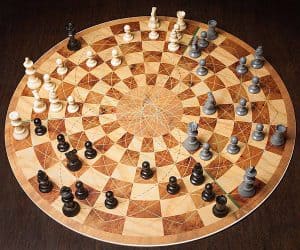


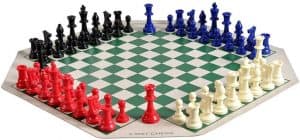
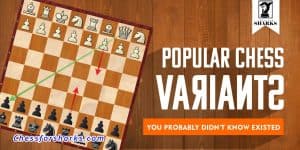
join the conversation